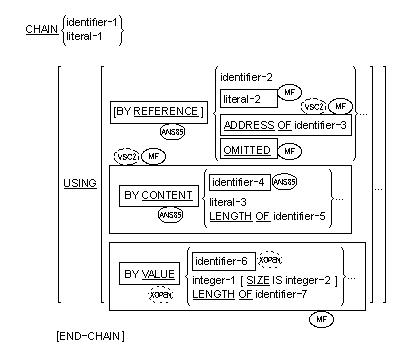The CHAIN statement transfers control from one object program to another in the run unit with no subsequent return of control. The effect is as though the chained program is the main program in the new run unit.
General Format

Syntax Rules
- The syntax of the CHAIN statement is similar to the syntax of the CALL statement and the two are subject to common syntax rules as indicated in the topic The CALL Statement. All the identifiers, literals and integers in the general format of the CHAIN statement correspond to the identifiers, literals and integers of the CALL statement.
General Rules
- Literal-1 or the content of the data item referenced by identifier-1 is the name of the chained program. The program in which the CHAIN statement appears is the chaining program.
The chained program must be a COBOL program that is not a nested program. The name of the chained program must contain the name contained in the Program-ID paragraph of the chained program (seethe section The Program-ID Paragraph, particularly in regard to case sensitivity). Alternatively, the name of the chained program may contain a name which identifies a file that contains executable program code for the chained program. See your COBOL system documentation for details of how your system matches the given name to previously chained programs, program filenames or programs held in library files.
- If, when a CHAIN statement is executed, the program specified by the CHAIN statement is made available for execution, control is transferred to the chained program, and the chaining program, and any COBOL programs called by the chaining program, are canceled. The chained program is not under the control of a chaining program and so any EXIT PROGRAM executed within the chained program has no effect.
- If, when a CHAIN statement is executed, the program specified by the CHAIN statement is not made available for execution, then a fatal run-time error is given.
- Chained programs can contain CHAIN statements. A CHAIN statement within a chained program may reference any program except itself.
- The form of the CHAIN statement is similar to the form of the CALL statement and the two are subject to common general rules as indicated in the topic The CALL Statement. All the identifiers, literals and integers in the general format of the CHAIN statement correspond to the identifiers, literals and integers of the CALL statement. Also, where the expressions calling program and called program are used, these can be considered equivalent to the expressions chaining program and chained program.
- The chain operation moves the value from each data item referenced in the USING phrase of the CHAIN statement to the data item referenced by the corresponding data-name in the USING phrase of the PROCEDURE DIVISION header of the chained program.
- The value of any data item with USAGE POINTER or USAGE PROCEDURE-POINTER that is passed as an operand in the USING phrase must not represent the address that was originally derived from a COBOL data item.
- The END-CHAIN phrase delimits the scope of the CHAIN statement.
- The USING phrase must not be used if you have specified the Compiler directive INTLEVEL"1".








